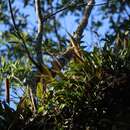en
names in breadcrumbs


Phreatia, commonly known as lace orchids,[2] is a genus of flowering plants from the orchid family, Orchidaceae, native to regions bordering the Pacific and Indian Oceans. Plants in this genus are epiphytes, sometimes with pseudobulbs, in which case there are usually one or two leaves. Others lack pseudobulbs but have up to twelve leaves. A large number of small white or greenish flowers are borne on a flowering stem emerging from a leaf axil or from the base of the pseudobulb when present but the flowers do not open widely. There are about 220 species, distributed from tropical and subtropical Asia to the Pacific.
Orchids in the genus Phratia are epiphytic herbs similar to those in the genus Thelasis and sometimes have pseudobulbs with one or two leaves or otherwise lack pseudobulbs and have up to twelve leaves. A large number of small flowers are arranged on a flowering stem that emerges from the top of the pseudobulb when present or from a leaf axil. The flowers are resupinate, usually white or greenish and do not open widely. The sepals and petals are free from and similar to each other, but the petals are slightly smaller. The lateral sepals form a small ledge or "mentum" with the base of the column. There is sometimes a sac-like structure at the base of the labellum.[2][3][4][5]
The genus Phreatia was first formally described in 1830 by John Lindley and the description was published in his book The Genera and Species of Orchidaceous Plants.[1][6][7] The name Phreatia is derived from the Ancient Greek word phreatos meaning "a well" or "reservoir".[8]
The following is a list of Phreatia species accepted by the World Checklist of Selected Plant Families as at January 2019:[1]
Orchids in the genus Phreatia are found in China, Taiwan, the Indian Subcontinent, the Andaman Islands, Thailand, Vietnam, Borneo, Java, the Lesser Sunda Islands, Peninsular Malaysia, the Maluku Islands, the Philippines, Sulawesi, Sumatra, Christmas Island, the Bismarck Archipelago, New Guinea, the Solomon Islands, Norfolk Island, Queensland (Australia), Fiji, Niue, New Caledonia, Samoa, the Santa Cruz Islands, Tonga, Vanuatu, Wallis and Futuna Islands, the Society Islands, the Caroline Islands and the Mariana Islands.[1]
Phreatia, commonly known as lace orchids, is a genus of flowering plants from the orchid family, Orchidaceae, native to regions bordering the Pacific and Indian Oceans. Plants in this genus are epiphytes, sometimes with pseudobulbs, in which case there are usually one or two leaves. Others lack pseudobulbs but have up to twelve leaves. A large number of small white or greenish flowers are borne on a flowering stem emerging from a leaf axil or from the base of the pseudobulb when present but the flowers do not open widely. There are about 220 species, distributed from tropical and subtropical Asia to the Pacific.